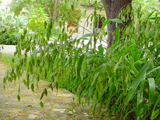Native Plants

Q. Who is Mr. Smarty Plants?
A: There are those who suspect Wildflower Center volunteers are the culpable and capable culprits. Yet, others think staff members play some, albeit small, role. You can torture us with your plant questions, but we will never reveal the Green Guru's secret identity.
Did you know you can access the Native Plant Information Network with your web-enabled smartphone?
Ask Mr. Smarty Plants is a free service provided by the staff and volunteers at the Lady Bird Johnson Wildflower Center.

rate this answer
Tuesday - June 17, 2008
From: Newport News, VA
Region: Southeast
Topic: Erosion Control
Title: Plants to stop erosion on land near lake
Answered by: Nan Hampton
QUESTION:
My back yard runs down to the lake. The water is eroding my land. I want plants & flowers [full sun]that can be planted to stop the erosion and add color. Another question: We have a huge oak tree in our front yard. We have had the hardest time getting grass to grow around that area. What do you suggest? We live in Newport News, VA.ANSWER:
Grasses are going to be the most effective plants to stop the erosion. Their fibrous root systems are excellent for holding the soil in place. After the grasses have stabilized the erosion, you can add wildflowers and shrubs, if you like. Here are some grasses and sedges that should do well in your lawn to stop the erosion.Andropogon glomeratus (bushy bluestem) grows well in moist areas in full sun and is attractive when green and after it has matured
Bouteloua dactyloides (buffalograss) grows well in sun and grows only to about 12 inches without mowing
Elymus canadensis (Canada wildrye)
Muhlenbergia capillaris (hairawn muhly)
Muhlenbergia cuspidata (plains muhly)
Schizachyrium scoparium (little bluestem)
Carex blanda (eastern woodland sedge)
Carex pensylvanica (Pennsylvania sedge)
Carex stipata (owlfruit sedge)
Rhynchospora colorata (starrush whitetop) will do well next to the shoreline in the wettest soil
I think it is the constant shade that is affecting the growth of grasses under your oak tree. Some tree species can inhibit the growth of plants beneath them by chemicals released from leaves, roots and fallen debris (e.g., Juglans nigra, black walnut), a process called allelopathy. You can read about the "Potential Allelopathy in Different Tree Species". You don't say which oak you have, but several of oaks on that list in the "Strongest Effect" category do occur in Virginia (Quercus falcata (southern red oak), Quercus marilandica (blackjack oak), Quercus rubra (northern red oak), and Quercus stellata (post oak)). If your oak is one of these species, you can help your situation by keeping the oak leaf, twig, and acorn litter raked from under the tree. Also, you should try grasses that do well in the shade. Here are a few suggestions, some of which are recommended for stopping erosion above:
Bouteloua curtipendula (sideoats grama)
Carex blanda (eastern woodland sedge)
Carex pensylvanica (Pennsylvania sedge)
Chasmanthium latifolium (Inland sea oats)
Elymus canadensis (Canada wildrye)
More Erosion Control Questions
Plants for controlling erosion on a cleared slope in Ohio
April 29, 2009 - I live in Cincinnati, OH. BP owns a pipeline which runs thru part of my property. They clear out all the large trees every few years, so that it is visible from the air. Our area is surrounded by M...
view the full question and answer
Erosion control in Charleston WV
August 26, 2009 - I live in Charleston, WV and just purchased a home that has a hill side out back that has some erosion occurring. I was wondering what would be the best ground cover to plant in my area to control the...
view the full question and answer
Plants to prevent erosion in clay soil in Heron, NY
September 07, 2009 - What plants could be used to plant on clay soil, Eastern exposure in full sun to stop erosion on a bay side hill with a steep grade?
view the full question and answer
Plants for steep embankment on the Missouri River in Nebraska
July 01, 2009 - Hi, My embankment along the Northeast Nebraska shoreline
of the Missouri River is eroding the land away. Do you have
any suggestions for seed I could throw over the side of
the bank that would grow...
view the full question and answer
Groundcover for erosion control in Missouri
July 23, 2008 - Can you suggest a ground cover to stop erosion on a slight slope in my backyard? I live in Missouri - the soil is very poor in this area and has lots of rock underneath the soil. The yard drains int...
view the full question and answer
| Support the Wildflower Center by Donating Online or Becoming a Member today. |

